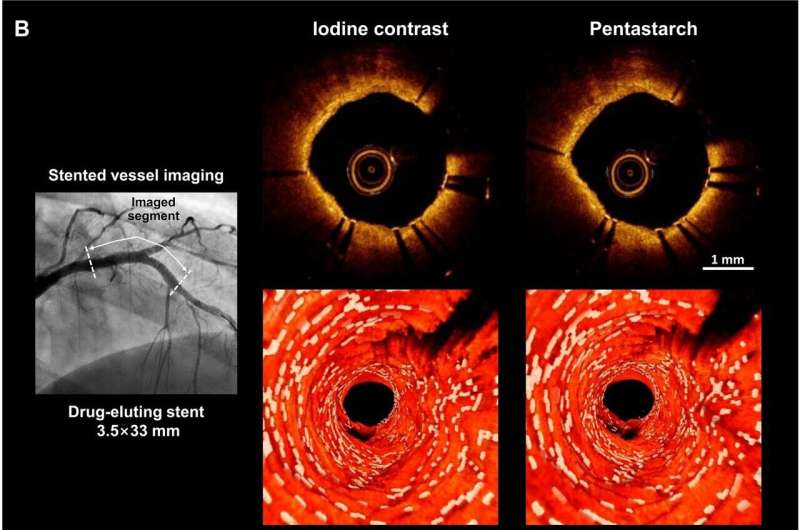This article has been reviewed according to Science X's editorial process and policies. Editors have highlighted the following attributes while ensuring the content's credibility:
fact-checked
peer-reviewed publication
proofread
First-in-the-field application of non-contrast optical coherence tomography for coronary artery disease

A research team has demonstrated the clinical feasibility and safety of non-contrast optical coherence tomography (OCT) for patients with coronary artery disease.
Intracoronary OCT enables physicians to clearly visualize coronary microstructures and provides precise assessment of procedural optimization following coronary stent implantation. Despite its widespread availability in contemporary catheterization laboratories, this imaging modality has inherent limitations, requiring a flushing solution for image acquisition.
To obtain clear images, a flushing media must be injected into the coronary arteries to temporarily displace blood and prevent signal attenuation caused by red blood cells. The most commonly used flushing media is radiological iodine contrast, which is known as a major risk factor for worsened renal function with increased amount of usage.
Demonstrating the clinical feasibility and safety of a non-contrast optical coherence tomography
Prof. Jin Won Kim and Dong Oh Kang's research team introduced a pioneering approach by utilizing plasma expander fluid (10% hydroxyethyl starch) as an alternative to iodine contrast agents. Their study validated the clinical feasibility and in-vivo biosafety of a non-contrast OCT imaging for patients undergoing coronary stent implantation.
This innovative non-contrast OCT imaging using hydroxyethyl starch solution demonstrated intracoronary images of equivalent quality to those obtained using conventional iodine contrast agent.
After implementing an automated customized pixel-based image analysis algorithm, the measurements of blood vessel diameter/volume and overall blood clearance levels showed comparable results between the paired images obtained using iodine contrast and non-contrast media. Importantly, this non-contrast OCT imaging showed no additional complications or side effects, ensuring the safety of the image acquisition process for all participants included in the study.
The first authors of this research paper, Prof. Dong Oh Kang and Hyeong Soo Nam, said, "We introduced an innovative imaging strategy that can replace conventional iodine contrast agents for obtaining intracoronary OCT images. Our study stands as the world's first demonstration of the clinical feasibility and safety of this novel imaging methodology."
"We expect that this new imaging technique will offer a convenient and safe intracoronary imaging diagnostic option for patients encountering challenges with using iodine contrast, thereby facilitating OCT procedures for a broader range of individuals."
The senior authors of this research paper, Prof. Jin Won Kim and Hongki Yoo, remarked, "Our study thoroughly validated the accuracy and reproducibility of this new imaging technique utilizing our automated customized pixel-based image analysis algorithm. The present analytic method holds immense scientific significance, serving as the fundamental basis for the broader clinical application of this imaging technique."
They further added, "In particular, this imaging technique will provide an important breakthrough for the first-in-human clinical trial of next-generation intravascular multi-modal molecular imaging technology which requires non-contrast flushing for image acquisition."
The findings are published in the journal Scientific Reports.
More information: Dong Oh Kang et al, Feasibility and safety of non-contrast optical coherence tomography imaging using hydroxyethyl starch in coronary arteries, Scientific Reports (2023). DOI: 10.1038/s41598-023-40363-7



















